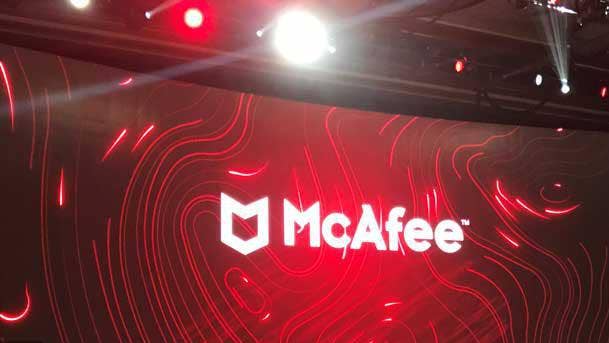10 Things To Know About The $4B STG-McAfee Enterprise Deal
From STG’s brief history in cybersecurity to layoffs and executive turnover in McAfee’s enterprise division to years of rumors about such a split, here are 10 key things to know about STG’s acquisition of McAfee’s enterprise business.

Another New Beginning
Private equity firm Symphony Technology Group (STG) agreed Monday to buy McAfee’s enterprise business for $4 billion, turning the cybersecurity stalwart into a pure-play consumer business. McAfee’s $1.33 billion enterprise business will be rebranded in the coming months while its $1.56 billion consumer business will continue to be publicly traded under the McAfee name, the company said.
“We are excited about the decision to divest the enterprise business,” McAfee President and CEO Peter Leav told investors Monday morning. “It is a terrific business. We‘re also excited about STG as a partner; [we’re] excited for our employees.”
From STG’s brief history in cybersecurity to layoffs and executive turnover in McAfee’s enterprise division to years of rumors about such a split, here are the 10 biggest things to know about STG’s monster acquisition of McAfee’s enterprise business.

10. Split Has Been Rumored Since Late 2019
Reports of McAfee looking to separate its enterprise and consumer businesses first started in December 2019, when The Wall Street Journal reported that McAfee was looking at joining its own consumer business with the $2.41 billion pure consumer operation of Tempe, Ariz.-based rival NortonLifeLock. Under that scenario, McAfee’s enterprise and consumer units would have had different owners.
A month later, McAfee hired former BMC Software and Polycom CEO Peter Leav as its top leader. Leav’s previous CEO stints were relatively brief (both under three years), and both included courting a strategic buyer (and, in one case, reaching a preliminary acquisition agreement) before ultimately settling on a sale to a private equity firm.
Less than 18 months after joining BMC Software as CEO, Leav facilitated the company’s sale to private equity giant KKR for a reported $8.5 billion, according to Reuters. At his previous stop, Leav walked away from the Mitel-Polycom acquisition just three months after the deal was announced in favor of a $2 billion deal from private equity titan Siris Capital Group, which was 13.6 percent more than Mitel’s offer.

9. STG Is Relative Newcomer To Cybersecurity
STG has been around since 2002 investing in software, data and analytics leaders in the midmarket. But the Palo Alto, Calif.-based private equity firm shied away from cybersecurity until April 2019, when it took a majority stake in network modeling and risk scoring platform RedSeal for a reported $100 million, according to Momentum Cyber.
The following year, STG would make a much bigger splash with its $2.08 billion purchase of Bedford, Mass.-based encryption vendor RSA in September 2020. RSA’s tools include RSA Archer for governance, risk and compliance; RSA NetWitness for security incident event management and threat detection and response; RSA SecurID for identity and access management; and RSA Fraud & Risk Intelligence.
STG also took control over the RSA Conference, which is the world’s largest cybersecurity event and in 2019 drew more than 42,500 people and 700 vendors to San Francisco’s Moscone Center. The RSA Conference began in 1991 as a small cryptography conference and has grown over the decades to include a smaller multiday conference in Asia-Pacific as well one-day events in a few locations globally.

8. McAfee’s Consumer-Enterprise Split Mirrors Symantec
McAfee is following in the footsteps of top rival Symantec, which sold its enterprise business to Broadcom in November 2019 for $10.7 billion and continues to operate its consumer business under the NortonLifeLock brand. This time around, McAfee’s enterprise business will be rebranded while its consumer business will continue to be publicly traded under the McAfee name.
Symantec has suffered one blow after another to what was once the world’s largest pure-play cybersecurity business, with more than 10 high-ranking executives leaving the company in the 15 months following the Broadcom acquisition announcement. These departures were capped off by the exit of former Symantec Enterprise Head Art Gilliland, who became CEO of Centrify a few months later.
NortonLifeLock has fared better since the split, agreeing in December to purchase Avira from Investcorp for $360 million to strengthen its consumer cybersecurity and privacy offerings in Europe and other emerging markets. Since both NortonLifeLock and McAfee will soon be publicly traded pure-play consumer cybersecurity vendors, there is still the possibility of a merger between the two companies.

7. McAfee’s Consumer Team Has Outperformed Enterprise
McAfee’s enterprise business has struggled in recent years as its faces off against high-powered competitors like CrowdStrike and SentinelOne. Net revenue for the fiscal year ended Dec. 26, 2020, inched ahead to $1.35 billion, up just 1.2 percent from $1.33 billion a year earlier. And the division’s operating loss increased to $180 million, up 19.2 percent from $151 million a year earlier.
Like Symantec before its split, most of McAfee’s growth has been in its consumer business, where net revenue surged in the fiscal year ended Dec. 26, 2020, to $1.56 billion, up 19.6 percent from $1.3 billion a year earlier. And the division’s operating income skyrocketed to $333 million, up 20.2 percent from $277 million a year earlier.
“Following the close of the transaction, we will be focused exclusively on the large and growing consumer cybersecurity market and continuing to grow in this expanding TAM [total addressable market] with our market-leading consumer subscription business, resulting in sustained double-digit revenue growth, profitability at scale and strong cash flows,” Leav told investors Monday.

6. McAfee Has Laid Off Hundreds In Recent Months
McAfee initiated a workforce reduction in December 2020 to improve operating margins and reorient its enterprise business, and announced the move on Feb. 23 after affected employees had been notified. The company is spending $16 million in the fourth quarter of 2020 and $30 million to $35 million in the first half of 2021 on the restructuring, consisting of severance payments and other termination benefits.
The company notified the state of California Jan. 4 that it would be laying off 137 employees at its San Jose headquarters effective March 4. Three vice presidents of engineering and product management and two senior directors of sales and product management are among the higher-level employees to be laid off in the move, according to filings with the state.
McAfee also unveiled plans in January to move its Israeli operations overseas as a cost-cutting measure, meaning that most of the 50 research and development employees and 10 salespeople at the Tel Aviv facility will be laid off, Globes reported at the time. The facility been involved in McAfee’s development of products such as MVision Insights and McAfee Unified Cloud Edge, according to Calcalist.

5. McAfee Turned Over Nearly Entire C-Suite Since 2020
McAfee has reshuffled nearly its entire leadership team since early 2020. Former CEO Chris Young left the company on Feb. 3, 2020, and has since joined Microsoft to lead its global business development efforts. Young was replaced by Leav. McAfee Executive Vice President and CFO Michael Berry left the company on March 10, 2020, and took the same role at NetApp. Berry was replaced on Sept. 2 by Venkat Bhamidipati.
McAfee President and Chief Revenue Officer John Giamatteo left the company on Jan. 10, 2020, after overseeing the enterprise business group’s sales, marketing and customer success organizations for 18 months. More recently, Chief Product Officer Ash Kulkarni resigned Jan. 1 after two years spearheading McAfee’s enterprise product strategy to take the same role at search software vendor Elastic.
In addition, McAfee Senior Vice President of Cloud Rajiv Gupta left the company in January 2021, according to his LinkedIn page. Gupta joined McAfee through its $590 million acquisition of Skyhigh Networks in January 2018, where Gupta had been founder and CEO. The only top executive at McAfee in both January 2020 and today is Terry Hicks, who has led the company’s consumer business group since November 2018.

4. Acquisitions Possible For McAfee’s Consumer Business
The consumer cybersecurity market is growing rapidly due to major transformations in customer behavior, a proliferation of devices, increased internet connectivity and more online transactions, Leav told investors Monday. A significant increase in cyberthreats has also driven increased consumer demand for McAfee’s cybersecurity services, according to Leav.
In the coming months, Leav said McAfee will continue to assess organically where it can bring differentiated value to its consumer business from the user experience to partnering. Over time, Leav said McAfee will also look at inorganic opportunities for its consumer business since the level of cash production in the business gives the company more flexibility to make moves.
For now, though, Leav said McAfee is focused on debt paydown and dividends. And going forward, Leav said McAfee will look at what makes sense to continue driving profitable growth around its consumer operations.

3. Doherty, Singh Currently Oversee McAfee Enterprise
The current top leaders for McAfee’s enterprise business are Lynne Doherty (pictured), who has run sales, pre-sales, channel and marketing since May 2020, and Shishir Singh, who has led product strategy and execution on an interim basis since Jan. 1. Doherty previously led Cisco’s U.S. Commercial Sales team, and assumed many of Giamatteo’s responsibilities when she joined McAfee last spring.
Doherty spent nearly 15 years at Cisco, rising up the ranks to become senior vice president of U.S. commercial sales in August 2018. In that role, Doherty oversaw a team of more than 2,000 employees and was responsible for driving $8 billion in revenue annually through the sale of products and services to more than 400,000 accounts.
Singh, meanwhile, joined McAfee in October 2014 and was tasked with running the company’s network security business unit for nearly three years until assuming responsibility for the company’s web protection, data protection, CASB and network security products in April 2017. Prior to becoming the interim chief product officer for McAfee enterprise, Singh has been senior vice president of engineering.

2. McAfee Stock Surges To All-Time High Following Split
McAfee on Oct. 22 completed a $740 million initial public offering that valued the cybersecurity giant at $9.5 billion. The company’s stock is up $2.75 (12.98 percent) to $23.50 per share in trading early Monday afternoon, which is the highest the company’s stock has traded since the IPO. The all-cash deal is expected to close by the end of 2021, according to McAfee.
Private equity firm TPG held a majority stake in McAfee between April 2017 and October 2020, with Intel and private equity firm Thoma Bravo both holding minority stakes. All of McAfee was valued at $4.2 billion at the time of its 2017 spinout from Intel, well below the $7.6 billion Intel initially paid to acquire the company in 2010.
Four years later, STG valued McAfee’s enterprise business alone at $4 billion despite accounting for just 46.4 percent of the company’s revenue in the fiscal year ended Dec. 26, 2020. The adjusted EBITDA (earnings before interest, taxation, depreciation and amortization) for McAfee’s enterprise division was $335 million in 2020, meaning that STG paid a multiple of 11.9 times EBITDA to buy McAfee enterprise.

1. Two-Thirds Of McAfee Employees Will Join STG
McAfee in December employed 6,196 people across 44 countries, and Executive Vice President and Chief Financial Officer Venkat Bhamidipati told investors Monday that roughly two-thirds of the company’s employees are with the enterprise division and will be going over to STG as part of the sale.
“[We] firmly believe that with their stellar track record, and deep experience in cybersecurity, they [STG] will be the right partner to continue strengthening our enterprise business going forward and ensure continued success for the business‘ employees and customers,” Leav told investors Monday. “Our two businesses work well together, but they do not depend on one another.”
Forty-three percent of McAfee’s employees are based in North America, while 37 percent work out of Asia-Pacific and Japan (APJ), 16 percent are based in Europe and the Middle East, and 4 percent are in Latin America.